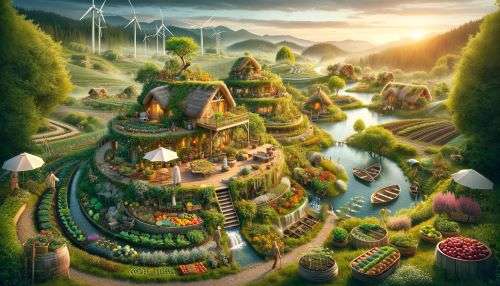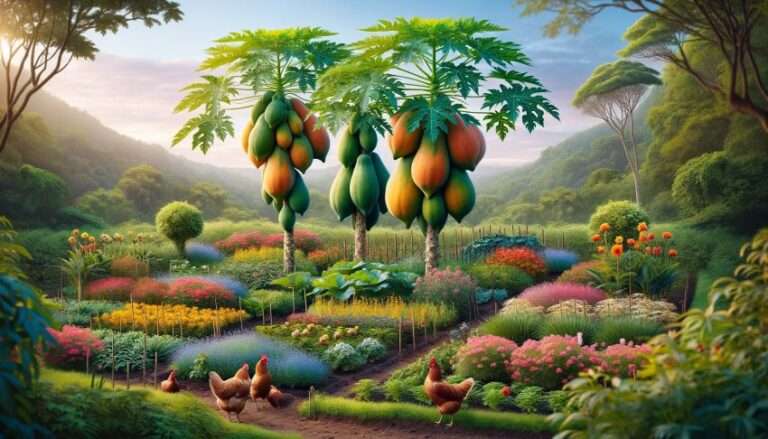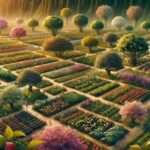This post contains affiliate links, through which we may earn a commission at no additional cost to you.
Table of Contents
Introduction: Unleashing Nature’s Bounty
Are you dreaming of transforming your backyard into a verdant wonderland? Look no further! Building Paradise: 7 Tips for Designing a Food Forest in a Tropical Climate is your go-to guide for cultivating a thriving oasis of edible delights. Picture this: a lush canopy of fruit-laden trees, a vibrant tapestry of herbs and vegetables, and a symphony of buzzing pollinators—all right in your backyard! Let’s embark on this green journey together and unlock the secrets to creating your very own tropical forest utopia!
Tip 1: Embrace the Tropical Vibes
Ah, the tropics—the land of eternal sunshine and balmy breezes! When designing your tropical food forest in a tropical climate, it’s essential to embrace the unique characteristics of your environment. Think palm trees swaying in the breeze, vibrant blooms bursting with color, and a soundtrack of chirping birds and buzzing insects. Let your imagination run wild and infuse your food forest with the laid-back, tropical vibes that define paradise!
Sub-tip: Go Bananas!
Bananas aren’t just for smoothies—they’re the ultimate tropical staple! Incorporate a variety of banana cultivars into your food forest, from sweet ‘Cavendish’ to creamy ‘Lady Finger.’ With their vibrant green leaves and sweet, delectable fruit, bananas ring a slice of the tropics right into your own backyard sanctuary!
Tip 2: Diversity is Key
In the world of tropical forests, diversity reigns supreme! When selecting plants for your tropical paradise, aim for diverse species to create a resilient and thriving ecosystem. From towering fruit trees to low-growing ground covers, each plant plays a vital role in supporting the vitality and yield of your food forest. Embrace variety and let your garden become a melting pot of flavors, textures, and colors!

Sub-tip: Mix it Up!
Get creative with your plant selections and mix things up! Combine fruit trees with nitrogen-fixing legumes, companion plants, and beneficial herbs to create a harmonious and productive food forest ecosystem. Diversifying your plantings will enhance biodiversity, maximize yields, and minimize pests and diseases. You and Mother Nature both come out on top!
Picture your food forest in a tropical climate as a layered cake
Designing a 7-layered food forest in a tropical climate offers an exciting opportunity to explore the synergy between different plants, maximizing biodiversity and productivity in a relatively small space. Each layer plays a particular role in the ecosystem, supporting a variety of wildlife and creating an autonomous environment. Here’s a detailed guide to designing your tropical forest paradise with five great plants for each layer and tips on planting arrangement.
- Canopy Layer
- Plants: Mango, Coconut Palm, Durian, Breadfruit, Avocado
- Tips: These towering giants should be spaced well apart to allow for their total growth, both in height and canopy spread. Plant them at your plot’s north or west side to minimize shading on the lower layers.
- Low-Tree Layer (Sub-canopy)
- Plants: Banana, Papaya, Sapote, Moringa, Jackfruit
- Tips: Intersperse these amongst the more giant canopy trees, placing faster-growing species like banana and papaya where they can be easily replaced or removed as the canopy fills in. Consider the eventual size and light requirements of each species.
- Shrub Layer
- Plants: Pineapple Guava, Hibiscus (edible varieties), Coffee, Cacao, Turmeric
- Tips: Plant these under the protection of the low-tree layer, utilizing the shade provided. Some shrubs, like turmeric, thrive in partial shade, while others, such as coffee and cacao, prefer more specific conditions.
- Herbaceous Layer
- Plants: Lemongrass, Ginger, Basil, Chives, Taro
- Tips: These can be planted more densely and used to fill gaps, providing ground cover to keep the soil moist. Many herbs are also beneficial for pest control and can be interspersed throughout the forest to serve as companion plants.
- Ground Cover Layer
- Plants: Sweet Potato, Peanut, Strawberry, Cover Crops (e.g., clover), Squash
- Tips: These plants quickly cover bare soil, retaining moisture and suppressing weeds. They should be spread throughout the understory, but be mindful of their tendency to spread and potentially compete with other plants for space.
- Rhizosphere (Root Layer)
- Plants: Carrot, Beets, Yams, Cassava, Radish
- Tips: Incorporate these into the forest with enough soil depth and little competition from the roots of more giant trees. It’s a good idea to grow them near the edge of planting beds for easier harvesting without disturbing other plants.
- Vertical Layer (Climbers)
- Plants: Passion Fruit, Vanilla Orchid, Climbing Spinach, Chayote, Kiwano (Horned Melon)
- Tips: Utilize the vertical space by training these climbers on trees, trellises, or any vertical structure. Place them where they can climb without overshadowing other plants, often at the edges or on the south side of trees, to capture sunlight efficiently.
Planting Arrangement Tips
- Start with the Canopy: Plant your canopy layer, as these trees will take the longest to mature. This will set the stage for the rest of your food forest.
- Consider Sunlight: Ensure that all plants receive the appropriate amount of sunlight by carefully considering their placement about each other and the sun’s movement across your site.
- Plan for Growth: Remember that plants will grow! Leave enough space between them to accommodate their mature size and avoid overcrowding and resource competition.
- Layer Strategically: Integrate plants from different layers close to each other to create microclimates and symbiotic relationships. For example, nitrogen-fixing shrubs can benefit the growth of nearby fruit trees.
- Water Wisely: Design your food forest with water management in mind. Place thirstier plants in areas where they can access water quickly, and consider a swale or drip irrigation system for efficient watering.
- Promote Biodiversity: The more species you include, the more resilient your food forest will be. Strive for a blend of both annual and perennial plants to keep the tropical forest productive year-round.
A food forest in a tropical climate is a dynamic, living ecosystem that changes over time. Regularly observing and interacting with your tropical food forest will allow you to make adjustments and understand the unique relationships within your edible paradise.
Tip 3: Work with Mother Nature, Not Against Her
When it comes to designing a tropical food forest in a tropical climate, it’s all about working in harmony with Mother Nature. Take cues from the natural world around you and mimic the structure and function of a native forest ecosystem. From layering plants to enhancing soil fertility, let nature guide you as you create a thriving and sustainable tropical food forest paradise.
Sub-tip: Harness the Power of Mulch
Mulch is nature’s secret weapon for building healthy soil and conserving tropic moisture! Layer organic mulches like shredded leaves, straw, and grass clippings around your plants to suppress weeds, retain moisture, and nourish the soil. As the mulch decomposes, it liberates nutrients, feeding your plants and promoting soil health. Plus, it’s a great way to recycle organic matter and reduce waste in your garden!
Tip 4: Design for Succession
In the ever-changing landscape of a food forest in a tropical climate, succession is the name of the game! Design your tropical paradise with an eye toward long-term productivity and sustainability by incorporating plants with varying growth habits and lifespans. From fast-growing pioneers to slow-maturing climax species, Each plant holds a vital position within the ever-evolving dynamics process of ecological succession.
Sub-tip: Plan for the Future
Look forward and prepare for what’s to come by carefully selecting and positioning trees and shrubs. These plants will offer protection, comfort, and nourishment for many years ahead. Consider your plants’ growth habits and mature sizes, and space them accordingly to prevent overcrowding and resource competition. By planning for succession, you’ll ensure that your food forest continues to thrive and evolve, becoming more resilient and productive with each passing season!
Succession planting in a tropical food forest involves strategically introducing plants that thrive at different stages of the forest’s development, ensuring continuous productivity and ecological balance. Here are three practical examples of succession planting, showcasing how to layer your planting strategy for a flourishing, self-sustaining food forest in a tropical climate.
Fast-Growing Annuals to Perennial Understory
Initial Stage: Start with fast-growing, nutrient-hungry annuals that thrive in full sunlight, such as beans, squash, and corn. These plants act as pioneers, quickly covering bare soil, providing food, and adding organic matter.
Transition: As your canopy layer begins to establish and create more shade, transition to shade-tolerant perennial understory plants. Suitable choices include taro, ginger, and turmeric, which can thrive under the dappled light beneath the developing canopy.
Example Succession:
- Year 1: Plant beans, squash, and corn to take advantage of full sun while canopy trees are young.
- Year 2-3: As canopy trees grow, introduce taro, ginger, and turmeric in the spaces between, benefiting from the increased shade.
Nitrogen-Fixing Plants to Fruit Trees
Initial Stage: Incorporate nitrogen-fixing plants such as pigeon pea, cowpea, and leucaena in the early stages of your food forest. These plants improve soil fertility by fixing atmospheric nitrogen, benefiting neighboring plants and preparing the land for more demanding crops.
Transition: Once the soil is enriched and the nitrogen-fixers have begun to mature, plant fruit trees like mango, avocado, and papaya amongst them. The improved soil fertility supports the growth of these fruit trees, which will eventually overtop and replace the nitrogen-fixers.
Example Succession
- Initial Planting: Sow seeds of pigeon pea, cowpea, and leucaena.
- Year 2-4: As nitrogen-fixers establish, interplant with young fruit trees. The fruit trees will benefit from the improved soil and begin to form the primary structure of your food forest.
Ground Covers to Climbing Vines
Initial Stage: Begin with ground-cover crops like sweet potato, peanut, and cover crops like clover. These plants cover the soil quickly, retain moisture, suppress weeds, and can be harvested for food or green manure.
Transition: As your food forest matures and vertical structures like trees and trellises become available, introduce climbing vines such as passion fruit, climbing spinach, and chayote. These vines will use the vertical space efficiently, increasing the productivity of your forest.
Example Succession
- Year 1: Plant ground covers to establish a living mulch and provide immediate yields.
- Year 2-3: As trees grow and structures like trellises are added, plant climbing vines at the base of these supports. They’ll climb up, maximizing the use of vertical space in the maturing food forest.
Herbaceous Layer Transition to Shrub Layer
Initial Stage: Start with fast-growing, sun-loving herbs and small plants that can quickly take advantage of the open spaces and sunlight in your newly established food forest. Examples include annual vegetables like lettuce, spinach, and radishes, which can be harvested within a short period.

Transition: As your tropical food forest begins to fill in and more shade is created by the development of canopy and sub-canopy layers, transition the area to include shade-tolerant shrubs and perennials that will form the permanent understory. Suitable plants for this layer include coffee, cacao, and pineapple guava. These plants take longer to mature but will provide yields for many years.
Example Succession
- Year 1: Plant quick-growing, sun-loving herbs and vegetables to utilize the open, sunny spaces.
- Year 2-5: Gradually introduce coffee, cacao, and pineapple guava as the forest canopy develops and creates more shade, transitioning the space from annual vegetables to a productive shrub layer.
Temporary Windbreaks to Permanent Forest Edge
Initial Stage: In the early stages of a food forest, particularly in wind-prone areas, establishing temporary windbreaks can protect young, vulnerable plants. Fast-growing, wind-resistant species such as vetiver grass, bamboo, or certain types of fast-growing legumes can effectively serve this purpose.
Transition: Over time, as the main body of the food forest matures and becomes more resilient to wind, the temporary windbreaks will transition to more permanent, productive edge species. These might include dense, fruit-bearing shrubs or trees that continue to protect the forest and add to its yield. Examples include citrus trees, pomegranates, and feijoa, which can handle windier conditions and provide food and habitat.
Example Succession
- Initial Planting: Establish vetiver grass or bamboo on the windward edge of your food forest to act as a temporary windbreak.
- Year 3-5: Once the forest’s interior has been established and the need for intense wind protection decreases, plant citrus trees, pomegranates, and feijoa to replace or complement the initial windbreak. These species will provide a more permanent edge to the food forest, contributing to its diversity and productivity.
These examples illustrate how succession planting can be strategically used to develop a productive and sustainable food forest. By strategically timing your plantings and choosing species that mutually benefit one another, you can foster a vibrant ecosystem that produces a rich variety of foods all year round.
Tip 5: Water Wisely
In the tropics, water is both a blessing and a challenge. While abundant rainfall provides a natural source of hydration for your food forest, managing water wisely is essential to prevent waterlogging and soil erosion. Incorporate water-saving techniques like rainwater harvesting, drip irrigation, and swales to capture and retain moisture in your garden, even during the dry season.
Sub-tip: Go with the Flow
Please work with the natural contours of your landscape and design your tropical food forest to capture and channel rainfall where it’s needed most. Create swales and berms to slow the water flow, allowing it to percolate into the soil and recharge groundwater reserves. By harnessing the power of rainwater, you’ll conserve water and enhance the resilience and productivity of your tropical paradise! Here are three practical techniques for integrating plants into your tropical food forest.
Swales on Contour
Swales are shallow trenches dug along the contour lines of a slope, designed to capture and hold rainwater, allowing it to infiltrate the soil rather than run off the surface slowly. Planting along these swales can maximize water usage and minimize erosion.
Technique: Identify the contour lines on your land using a level or A-frame. Dig swales along these lines, and mound the excavated soil on the downhill side to create a berm. Plant deep-rooted trees and shrubs on the berms to stabilize them and utilize the captured water.
Plants
- Berm: Fruit trees such as Citrus spp. (lemons, oranges), Persea americana (avocado) and Mangifera indica (mango).
- Swale: Nitrogen-fixing species like Crotalaria juncea (sunn hemp) and leguminous shrubs such as Calliandra calothyrsus to improve soil fertility and structure.
Rain Gardens
Rain gardens are crafted to intercept runoff from impermeable surfaces such as rooftops, driveways, and packed pathways. They are planted with species that can tolerate both wet and dry conditions, filtering rainwater and allowing it to recharge the groundwater.
Technique: To avoid waterlogging, locate your rain garden at least 10 feet away from your home. Choose a natural depression or create one in an area where water tends to collect. The garden should be slightly bowl-shaped and have a mix of sandy soil to promote infiltration.
Plants
- Center (Wet Zone): Colocasia esculenta (taro) and Hibiscus moscheutos (swamp hibiscus).
- Edges (Moist Zone): Heliconia spp. (heliconias) and Alpinia purpurata (red ginger).
- Outer Edges (Dry Zone): Muhlenbergia capillaris (pink muhly grass) and drought-tolerant ornamentals like Lantana camara.
Terracing Steep Slopes
Terracing transforms steep slopes into a series of step-like levels, reducing soil erosion and runoff while creating flat areas for cultivation.
Technique: Start at the bottom of the slope and work your way up, creating terraces by cutting into the hill and moving the soil to form a flat planting area supported by a downslope wall. This wall can be reinforced with stones, logs, or other natural materials.
Plants
- Terraces: Crops like Zea mays (corn), Phaseolus vulgaris (beans), and Cucurbita spp. (squash) in a traditional Three Sisters mound technique.
- Terrace edges: Perennial herbs and flowers, such as Rosmarinus officinalis (rosemary) and Tagetes spp. (marigolds), to attract pollinators and beneficial insects.
Tip 6: Invite the Pollinators
The tropical forest is complete with a bustling community of pollinators! Bees, butterflies, birds, and bats serve as essential partners in pollinating flowers, playing a pivotal role in securing abundant yields. Create a welcoming pollinator habitat by planting diverse nectar-rich flowers, providing nesting sites, and avoiding harmful pesticides and herbicides.
Sub-tip: Plant for Pollinators
Choose attractive plants for pollinators and incorporate them throughout your tropical food forest to create a vibrant and inviting habitat.With fragrant herbs like lavender and rosemary at your fingertips, alongside native wildflowers such as bee balm and coneflower, the variety really is boundless! By prioritizing pollinator-friendly plants, you’ll support biodiversity and boost your garden’s productivity through enhanced pollination.
Creating a pollinator-friendly tropical food forest is essential for ensuring the health and productivity of your edible ecosystem. Pollinators such as bees, butterflies, birds, and bats are vital for pollinating many food crops, helping increase fruit sets and overall yields. Here are three practical ways to attract and support these beneficial creatures in your food forest, along with suggestions for their arrangement.
Plant a Diversity of Nectar and Pollen-Rich Flowers
Practical Ways
- Incorporate a variety of flowering plants that blossom at various times over the year, ensuring a steady supply of nourishment for pollinators.
- Choose various colors and shapes to attract a wide range of pollinators. For example, bees are attracted to blue and purple flowers, while butterflies prefer flat, open flowers they can land on.
- Include native plants, which are often more attractive to local pollinators and adapted to the climate.
Arrangement
- Plant flowers in clusters to create more visual impact and make it easier for pollinators to find them.
- Incorporate flowering plants at the edges of pathways or around the base of fruit trees, ensuring they are accessible to pollinators but not in the way of garden maintenance activities.
- Use flowering ground covers to fill gaps between larger plants. They provide beauty and habitat without taking up too much space.
Provide Nesting Sites and Habitats
Practical Ways
- Leave some areas of the garden undisturbed and wild to offer shelter and nesting sites for ground-nesting bees and other wildlife.
- Install bee hotels or nesting boxes to attract solitary bees and other beneficial insects.
- Maintain a small, shallow water source, such as a birdbath with stones for insects to land on, to provide essential hydration for pollinators.
Arrangement
- Position nesting sites and habitats near flowering plants to ensure easy access to food.
- Place bee hotels and bird baths at varying heights and locations throughout the tropical food forest to accommodate different species’ preferences and distribute pollinator activity evenly.
- Incorporate natural features like logs, rocks, and dense shrubs to create varied habitats that appeal to a broad spectrum of pollinators.
Avoid Pesticides and Create a Safe Environment
Practical Ways
- Practice organic gardening techniques to avoid harming pollinators with pesticides and herbicides.
- Employ organic pest management strategies by welcoming predator insects that target harmful pests or by implementing physical deterrents and traps.
- Create a layered canopy of plants to encourage a healthy ecosystem that naturally balances pests and predators, reducing the need for intervention.
Arrangement
- Design your food forest with a focus on plant diversity to encourage a balanced ecosystem. Various plants attract a wide range of beneficial insects that help control pests.
- Plants susceptible to pests are placed near their natural predators or companion plants that deter pests, creating a natural defense system without chemicals.
- Establish buffer zones of wildflowers or native plants around the perimeter of your food forest to act as a sanctuary for helpful insects and pollinators., enhancing overall biodiversity and ecosystem health.
By implementing these practical strategies and thoughtful arrangements, you can create a vibrant, pollinator-friendly tropical forest. This will support the local ecosystem and enhance the productivity and resilience of your edible tropical forest landscape.
Tip 7: Cultivate a Spirit of Adventure

Lastly, cultivate a spirit of adventure in your food forest paradise! Dive into a garden adventure, where every turn unveils a mosaic of taste, touch, and scent. Let the allure of unique fruits and ancient veggies guide your palate on an unparalleled flavor quest!
Sub-tip: Dare to Explore the Uncharted!
Dare to venture beyond the familiar and dive into the world of unique and exotic plants perfect for the tropical climate. The possibilities are endless, from tropical fruits like jackfruit and durian to exotic herbs like lemongrass and Thai basil! Don’t be afraid to take risks and try something new—you never know what delicious surprises await you in your tropical food forest paradise!
Suggested Reading List
- “Tropical Plants for Home and Garden” by William Warren and Kirsten Albrecht Llamas:
- This comprehensive guide offers a varied collection of tropical plants suitable for cultivation in both indoor and outdoor settings. Warren and Llamas delve into valuable insights concerning cultivation techniques, maintenance, and landscape design, covering everything from vibrant flowering specimens to lush foliage varieties. Complete with captivating photographs and meticulous descriptions; this book serves as an invaluable tool for tropical gardening enthusiasts aiming to cultivate vibrant and flourishing gardens.
- “Tropical Gardens of the Philippines” by Lily Gamboa O’Boyle, Elizabeth Reyes, et al.:
- Journey through the enchanting landscapes of the Philippines with this visually captivating book. O’Boyle, Reyes, and other contributors celebrate the rich diversity of tropical gardens in the Philippines, offering a glimpse into their design, history, and cultural significance. From traditional to contemporary garden styles, this book explores the unique blend of indigenous plants, architectural elements, and cultural influences that define Filipino garden aesthetics.
- “Gardening in the Tropics” by Olive Senior:
- Olive Senior shares her profound love and deep understanding of tropical gardening in this poetic and insightful book. Through vivid descriptions and personal anecdotes, Senior invites readers to embrace the challenges and rewards of gardening in tropical climates. From battling pests to celebrating the beauty of indigenous flora, this book celebrates the resilience and creativity inherent in tropical gardeners.
- “Tropical Flowering Plants: A Guide to Identification and Cultivation” by Kirsten Albrecht Llamas:
- Dive into the world of tropical flowering plants with this comprehensive guide by Kirsten Albrecht Llamas. This book is an invaluable resource for plant enthusiasts, botanists, and gardeners alike. Llamas provides expert advice on cultivation techniques, propagation methods, and plant identification, making this book an essential companion for anyone interested in tropical flora.
FAQs: Answers to Your Burning Questions!
What are the best plants to grow in a tropical climate food forest?
Fruit trees like mango, papaya, and banana, alongside perennial vegetables and herbs such as taro and lemongrass, thrive in the warm, humid conditions of a tropical climate food forest.
How do you start a food forest in a tropical climate?
Begin by designing your layers from canopy to ground cover, selecting appropriate species for each layer, and preparing the soil with organic matter to support the diverse plant life
What are the benefits of a food forest in a tropical climate?
A tropical climate food forest promotes biodiversity, creates a self-sustaining ecosystem, provides a variety of foods throughout the year, and enhances soil health and water conservation.
Conclusion: Your Tropical Paradise Awaits!
Kudos to you! You’re setting off on an exciting adventure to cultivate a personal oasis, your very own edible paradise, right in the heart of the tropics. Following these 7 tips for designing a lush and bountiful tropical forest, you’ll unlock the secrets to cultivating a thriving ecosystem of edible delights. Time to pull up those sleeves, plunge your hands into the soil, and unleash your creativity to turn your backyard into a lush, tropical haven brimming with life and bounty! Building Paradise: 7 tips for designing a food forest in a tropical climate has never been more exciting—let the adventure begin!








